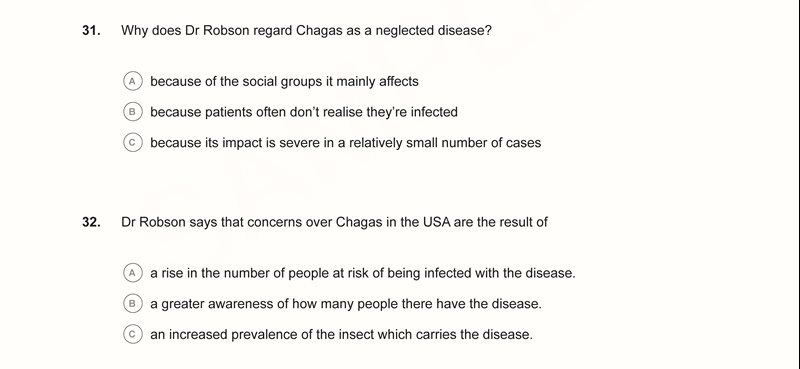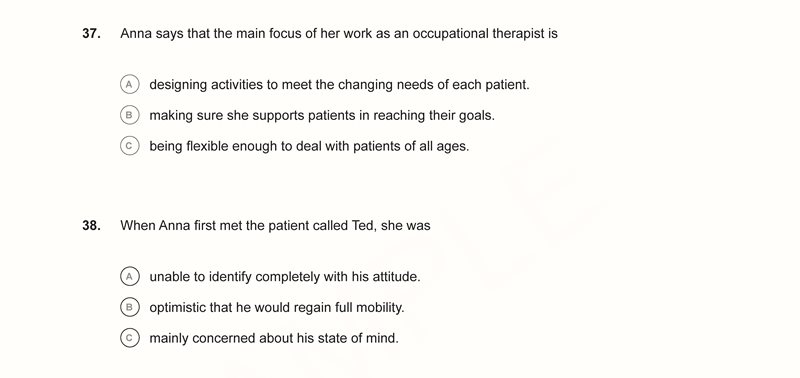
In OET Listening Part C, you hear two recordings which are either interviews or presentations, involving at least one healthcare professional. Part C audios are similar to those you would listen to as part of your professional development.
In this blog post, we will examine the format of the OET Listening Part C, the skills being tested, see a sample task and share some test tips and recommendations for Part C preparation.
OET Listening Part C format:
Here’s a summary of the OET Listening Part C format.
- Two audio recordings
- Presentation or interview
- Professional development-type audios
- 4-5 minutes each
- Six 3-option multiple-choice questions per audio
- 90 seconds to prepare
In OET Listening Part C, you hear two recordings which are either interviews or presentations, involving a healthcare professional. Part C audios are similar to those you would listen to as part of your professional development.
Some examples include workplace presentations, personal accounts of case studies or projects, presentations or discussions about research, trials, case studies or case reviews.
Each recording is around 4-5 minutes and has six 3-option multiple-choice questions. Before the audio begins, you have 90 seconds to read through the questions and answer options.
Skills for Listening Part C:
Listening Part C tests your ability to follow the logical flow of an extended presentation or interview and to understand the gist, or main idea, as well as attitude, that is, how someone feels about something, and opinion, what they think about something.
Sample Questions:
Part C begins with instructions, including a reminder to shade the circle completely for OET on paper. On computer, you select the correct answer with a left click of your mouse just like in Part B.
Each extract begins with a context statement, like this:

Then, there are the six questions and you need to select the correct answer from three options.
Before the interview or presentation begins, you have 90 seconds to read all the questions. As the audio plays, answer the questions in order.
.jpg?w=800)
.jpg?w=800)
OET Listening Part C question sheet
Test tips:
Here are 5 tips to succeed in Listening Part C.
1) Use your reading time wisely.
Start by reading all the questions quickly so that you will know how the audio will be structured and you will know when the speaker is moving to the next question. Then, return to the first question and go through the answer options, A, B, C as quickly as you can.
2) Use questions and signposting language in the audio to help you keep up.
The speakers will use language to indicate that they’re changing topics or that the next question is coming. In an interview, it could be the interviewer’s question. For instance, if you’re looking at question 31 (below) and you hear the interviewer ask: “Right, I see. Are there concerns in the USA about Chagas?” you should recognise that question 32 is coming.

Questions 31 and 32 from Listening Sample Test 1
In a presentation, listen for signposting language like:
- Let’s move on to talk about
- That brings me to my next point
- Let me tell you about
- In terms of,…
For example, if you’re looking at question 37 (from extract 2, Test 1), and you hear the audio: ‘Now, on to my case study. It involves a patient called Ted, a sixty-year-old man whose motorbike was in collision with a car’, you would know that it’s time for question 38 because the speaker has just introduced the patient, Ted. All your attention should then be on that question.

Questions 37 and 38 from Listening Sample Test 1
3) Prepare for paraphrase.
The speaker or speakers won’t use exactly the same words on the question sheet, so you need to be ready to listen for meaning, not just individual words.
4) Pay attention to linking words.
Linking words can signal important information that can affect your answer choice. Some common examples include:
- although
- but
- though
- however
- so
- because
Look at this question from Sample test 3 as an example.
Question 38 from Listening Sample Test 3
Here’s part of the audio from that section:
Patients sometimes worry that they’ve caused the condition by shaving or possibly by using depilatory creams, but there’s no evidence that either is a contributing factor.
That ‘but’ is a very important but. Option A seems possible – some people do worry that the blocked follicles are caused by shaving, BUT, Dr Cooper says there’s no evidence of that.
5) Don’t stop listening.
As you saw in the example above, it’s important to keep listening, even if you think you’ve heard the answer. This is because you will often hear words or ideas from all three options. Make sure you don’t stop listening when you hear something familiar.
Preparation recommendations:
As you prepare for Listening Part C, you will be improving your ability to listen to extended discussions and presentations on healthcare related topics and to understand how people present arguments, discuss research, explore case studies and other topics that will be a valuable part of your ongoing professional development.
Here are some suggestions to work on your skills for Part C.
1) Build your stamina.
Listening to extended audios takes effort and concentration. Use podcasts, TED talks and presentations to work on listening for long stretches of time without losing concentration. You can start with just one minute and work your way up.
2) Get comfortable with unfamiliar content.
On test day, you never know what topics might appear in Part C. You don’t need specialist knowledge of the topic because all the information you need will be provided in the audio. However, it’s good practice to listen to a wide variety of topics to help you become comfortable and confident listening to in-depth discussions or presentations on topics that are not your specialty.
Recommended podcasts:
- Business of healthcare (NPR)
- Health Report (ABC)
- Inside Health (BBC)
- Public Health on Call (Johns Hopkins Bloomberg School of Public Health)
- All in the Mind (ABC)
- Second Opinion (USA)
3) Practise summarising while listening.
Many part C questions test your ability to understand gist, that is, to gain meaning from an extended stretch of speech, perhaps, 2, 3 or 4 sentences. You can practise this before test day by listening to small sections of tests or podcasts and then writing a 1-sentence summary of what you heard. Then, listen again with the transcript to check you understood correctly.
4) Build your language knowledge.
Make sure you continually increase the amount of language you know. In Part C, you might need recognise why someone did something, how they feel about something, what other people think about something. What expressions do you know that show agreement, disagreement, concern, doubt? How might speakers suggest, recommend, discourage or warn? Do you know different ways to express cause, effect and reason? This is all valuable language to know. Use Part C transcripts to look for all the different words and ways that speakers express these ideas.
Find plenty of practice tasks on the OET website and store. Plus, we have over 10 hours of on-demand Listening Part C lessons on our YouTube channel.
Here are some helpful links:
Listening Part C on-demand lessons (YouTube)
Check out our other Listening Guides:
